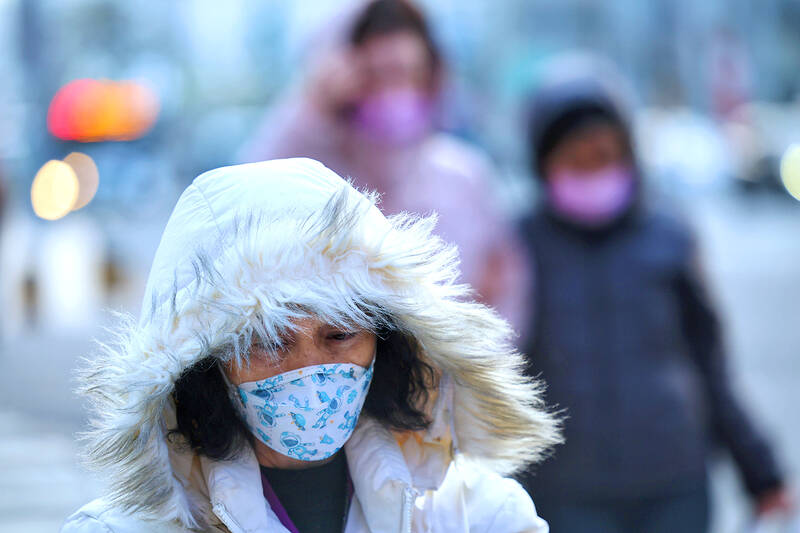On the question of whether “low-temperature leave” is possible for workers, the Ministry of Labor yesterday said that if employers do not take care of their employees according to its “work guidelines,” they could be fined up to NT$150,000.
Weather forecasts have said a cold wave would sweep southward from today, with temperatures dropping to lows of about 5°C in some flatland areas between Tuesday and Thursday.
The forecasts are reminiscent of the cold wave of January 2016, in which 12 schools nationwide suspended classes. The latest weather forecast has sparked public discussions over whether taking “low-temperature leave” would be possible.

Photo: CNA
The ministry yesterday said the “typhoon leave” people are accustomed to — where work and classes are canceled due to a typhoon — is not stipulated in the Labor Standards Act (勞動基準法). However, the Operation Regulations on the Suspension of Offices and Classes in Times of Natural Disasters (天然災害停止上班及上課作業辦法) stipulate that the matter is at the discretion of local governments, although the suspension of work technically applies only to government agencies as it would be impractical for all sectors of the economy to suspend operations during a typhoon.
However, if workers have “safety concerns” due to strong winds and heavy rain and cannot go to work, and government agencies are under work suspension, they should be considered as having justifiable reasons, and their employers “should not be harsh on them” or give them “unfavorable treatment,” the ministry said.
Regarding “low-temperature leave” or “high-temperature leave,” whether they can be deemed “natural disasters” remains to be discussed, it added.
However, the ministry’s Occupational Safety and Health
Administration has stipulated health and safety guidelines for working outdoors in cold weather, and employers are requested to ensure measures are put in place to ensure their employees are kept warm, especially paying attention to middle-aged and older employees’ health conditions and preventing hypothermia.
The administration said working in extreme cold weather could cause occupational incidents of heart or cerebrovascular diseases, and according to the Occupational Safety and Health Act (職業安全衛生法), employers are required to prepare three major safety and hygiene measures for outdoor work, including in construction projects, exterior wall cleaning, sign hanging, wire maintenance, delivery, agriculture and fishing.
In administrative management, they must remind workers to wear cold-resistant clothing, arrange sufficient rest time, provide hot drinks and establish a mutual protection mechanism among working partners.
In health management, workload and delegation should be appropriately adjusted according to the workers’ health conditions, exposure to cold weather should be reduced as much as possible and attention should be paid to the needs of elderly workers and workers with cardiovascular disease or other underlying health conditions, and medical assistance should be immediately sought when necessary.
In education and training, employers should hold low-temperature healthcare and safety and hygiene education training for their employees, teaching them how to prevent hypothermia and follow healthy and safety procedures, to reduce the risk of harm caused by low temperatures.
The ministry said employers should refer to the guidelines and prepare measures to help keep employees warm, and if they fail to follow the regulations resulting in harm to their employees by working in low temperatures without proper health and safety measures, they could be fined up to NT$150,000.

Actor Darren Wang (王大陸) was questioned by prosecutors for allegedly orchestrating an attack on a taxi driver after he was allegedly driven on a longer than necessary route in a car he disliked. The questioning at the New Taipei City District Prosecutors’ Office was ongoing as of press time last night. Police have recommended charges of attempted murder. The legally embattled actor — known for his role in the coming-of-age film Our Times (我的少女時代) — is under a separate investigation for allegedly using fake medical documents to evade mandatory military service. According to local media reports, police said Wang earlier last year ordered a

CAUTION: Based on intelligence from the nation’s security agencies, MOFA has cautioned Taiwanese travelers about heightened safety risks in China-friendly countries The Ministry of Foreign Affairs (MOFA) yesterday urged Taiwanese to be aware of their safety when traveling abroad, especially in countries that are friendly to China. China in June last year issued 22 guidelines that allow its courts to try in absentia and sentence to death so-called “diehard” Taiwanese independence activists, even though Chinese courts have no jurisdiction in Taiwan. Late last month, a senior Chinese official gave closed-door instructions to state security units to implement the guidelines in countries friendly to China, a government memo and a senior Taiwan security official said, based on information gathered by Taiwan’s intelligence agency. The

Taiwan Semiconductor Manufacturing Co (TSMC), the world’s largest contract chipmaker, said yesterday that it is looking to hire 8,000 people this year, at a time when the tech giant is expanding production capacity to maintain its lead over competitors. To attract talent, TSMC would launch a large-scale recruitment campaign on campuses across Taiwan, where a newly recruited engineer with a master’s degree could expect to receive an average salary of NT$2.2 million (US$60,912), which is much higher than the 2023 national average of NT$709,000 for those in the same category, according to government statistics. TSMC, which accounted for more than 60 percent

President William Lai (賴清德) should protect Taiwan Semiconductor Manufacturing Co (TSMC), and stop supporting domestic strife and discord, former president Ma Ying-jeou (馬英九) wrote on Facebook yesterday. US President Donald Trump and TSMC on Monday jointly announced that the company would invest an additional US$100 billion over the next few years to expand its semiconductor manufacturing operations in the US. The TSMC plans have promoted concern in Taiwan that it would effectively lead to the chipmaking giant becoming Americanized. The Lai administration lacks tangible policies to address concerns that Taiwan might follow in Ukraine’s footsteps, Ma wrote. Instead, it seems to think it could